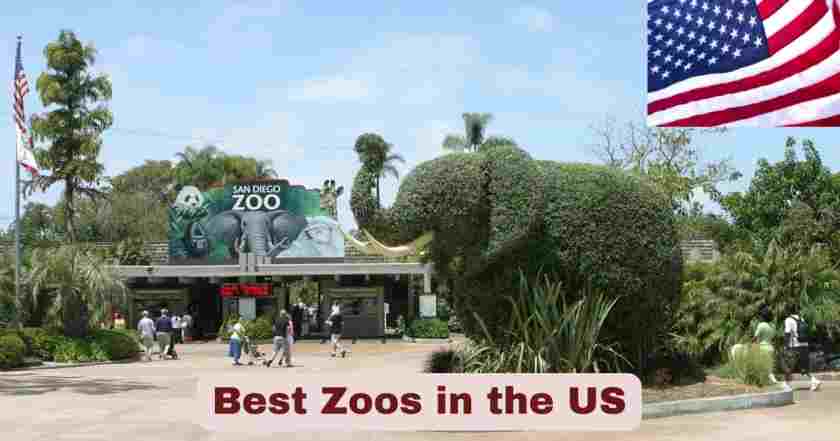Zoos in the US 2025
The American zoo landscape in 2025 represents one of the most sophisticated wildlife conservation networks globally, with facilities spanning across 46 states and the District of Columbia. These institutions have evolved far beyond simple animal exhibitions to become crucial centers for education, research, and species preservation. The Association of Zoos and Aquariums (AZA) continues to serve as the gold standard for accreditation, ensuring that only the highest-quality facilities receive recognition for their commitment to animal welfare and conservation excellence.
Modern zoos in the United States operate under stringent guidelines established by both federal agencies and professional organizations, with the United States Department of Agriculture (USDA) licensing approximately 2,800 animal exhibitors nationwide. However, what truly distinguishes the best zoos in America is their AZA accreditation status, achieved by fewer than 10% of all licensed facilities. This selective accreditation process ensures that visitors experience world-class animal care, educational programming, and conservation initiatives that directly contribute to global wildlife preservation efforts.
Latest Zoo Facts and Statistics in the US 2025
| Zoo Statistics Category | 2025 Data | Source |
|---|---|---|
| AZA-Accredited Facilities in US | 226 facilities | AZA Official Statistics |
| Total AZA Institutions Worldwide | 237 institutions | AZA March 2025 Report |
| States with AZA Facilities | 46 states + DC | AZA Geographic Data |
| Annual US Zoo Visitors | 183 million visitors | AZA Visitor Statistics |
| Global Zoo Visitors (AZA) | 200+ million visitors | AZA International Data |
| Total USDA Licensed Exhibitors | 2,800 facilities | USDA Licensing Data |
| AZA Accreditation Rate | Less than 10% | AZA Accreditation Standards |
| Full-Time Jobs Supported | 198,000+ positions | AZA Economic Impact Report |
| Annual Conservation Spending | $230 million | AZA Conservation Fund |
| Species Supported by Conservation | 800+ species | AZA Project Database |
| Countries with AZA Projects | 130 countries | AZA Global Reach Data |
| Total Conservation Grants | $7.7 million | AZA Historical Funding |
| Annual Animal Care Spending Range | $500,000 – $20 million+ | AZA Facility Operations |
The zoo industry statistics for 2025 reveal a remarkable commitment to excellence and conservation that extends far beyond entertainment value. With 226 AZA-accredited facilities operating across the United States, these institutions represent the pinnacle of animal care and educational programming. The selective nature of AZA accreditation becomes evident when considering that only a small fraction of the 2,800 USDA-licensed animal exhibitors achieve this prestigious status, demonstrating the rigorous standards these top-rated zoos must maintain.
The economic impact of American zoos in 2025 extends throughout local and national economies, supporting over 198,000 full-time positions while attracting 183 million annual visitors within the United States alone. These visitor numbers translate into significant revenue streams that fuel conservation efforts, with AZA-accredited zoos collectively investing $230 million annually in field conservation projects. This substantial financial commitment supports wildlife preservation initiatives benefiting more than 800 species across 130 countries, showcasing how modern zoo operations directly contribute to global biodiversity protection.
Best Zoos in the US
| Rank | Zoo Name | Location | Size (Acres) | Annual Visitors | Notable Features |
|---|---|---|---|---|---|
| 1 | San Diego Zoo | San Diego, California | 100 acres | 4.2 million | World-renowned conservation programs |
| 2 | Bronx Zoo | Bronx, New York | 265 acres | 2.2 million | America’s largest metropolitan zoo |
| 3 | Smithsonian National Zoo | Washington, DC | 163 acres | 2.5 million | Giant panda conservation center |
| 4 | Lincoln Park Zoo | Chicago, Illinois | 35 acres | 3.0 million | Free admission since 1868 |
| 5 | Houston Zoo | Houston, Texas | 55 acres | 2.55 million | Leading elephant conservation facility |
| 6 | Denver Zoo | Denver, Colorado | 84 acres | 2.3 million | High-altitude animal adaptations |
| 7 | Zoo Atlanta | Atlanta, Georgia | 40 acres | 1.3 million | Largest zoological collection in Southeast |
| 8 | Cincinnati Zoo | Cincinnati, Ohio | 75 acres | 1.87 million | America’s second oldest zoo |
| 9 | Central Park Zoo | New York City, New York | 6.5 acres | 1.2 million | Premium urban zoo experience |
| 10 | Oregon Zoo | Portland, Oregon | 64 acres | 1.6 million | Pacific Northwest wildlife expertise |
San Diego Zoo maintains its position as America’s premier zoological institution through groundbreaking conservation initiatives and innovative animal care practices. Located in California’s Balboa Park, this 100-acre facility houses over 4,200 animals representing 800 species, making it one of the world’s most biodiverse zoos. The zoo’s commitment to conservation extends globally through the San Diego Zoo Wildlife Alliance, which operates field programs in more than 35 countries. Their pioneering work in reproductive technologies, including the Frozen Zoo genetic repository, has revolutionized wildlife preservation efforts worldwide. The facility’s Skyfari gondola system and Reptile Walk provide unique viewing experiences that attract 4.2 million visitors annually.
The Bronx Zoo stands as America’s largest metropolitan zoo, encompassing 265 acres in the heart of New York City. The Bronx Zoo first opened in 1899 and has long been involved in conservation, with early conservation efforts including the creation of the American Bison Society in 1905. Today, the zoo operates Wildlife Conservation Society programs across 60 countries, protecting wildlife in their natural habitats. The facility’s Congo Gorilla Forest and Tiger Mountain exhibits showcase naturalistic environments that prioritize animal welfare while providing educational experiences for 2.2 million annual visitors. The zoo’s 4D Theater and Nature Trek climbing adventure add innovative elements to traditional zoo experiences.
Smithsonian National Zoo serves as both a premier tourist destination and a world-class research facility within the Smithsonian Institution. Spanning 163 acres in Washington, DC, the zoo attracts 2.5 million visitors annually while maintaining its commitment to free admission for all guests. The facility gained international recognition through its Giant Panda Conservation Program, which successfully bred and raised giant pandas for eventual release to China. The zoo’s American Trail exhibit features native species including sea lions, river otters, and bald eagles in naturalistic habitats. Research conducted at the Smithsonian Conservation Biology Institute in Virginia supports global conservation efforts across multiple continents.
Founded in 1868, Lincoln Park Zoo is among the most established zoos in the country and maintains its distinction as the second oldest zoo in the United States. This Chicago institution operates on 35 acres while offering completely free admission to all visitors, making it accessible to families regardless of economic circumstances. Drawing upwards of 3 million visitors a year due to its free admission, the zoo is nestled in the heart of Lincoln Park in an intimate setting with close views of animals in carefully designed habitats. The zoo’s Regenstein Center for African Apes and Robert R. McCormick Bear Habitat demonstrate how urban zoos can provide excellent animal care within limited space constraints.
Houston Zoo has emerged as a leader in elephant conservation and educational programming, operating on 55 acres while hosting 2.55 million visitors annually. The facility’s African Forest exhibit houses one of America’s most successful elephant breeding programs, contributing significantly to Asian elephant conservation efforts. The zoo’s Kipp Aquarium showcases marine ecosystems while the Children’s Zoo provides hands-on learning experiences for young visitors. Houston Zoo’s commitment to sustainability includes renewable energy initiatives and waste reduction programs that serve as models for other zoological institutions nationwide.
Denver Zoo operates at 5,280 feet above sea level, providing unique opportunities to study high-altitude animal adaptations while serving 2.3 million annual visitors. The facility’s 84-acre campus features specialized exhibits including the Toyota Elephant Passage and Predator Ridge, which house large mammals in expansive, naturalistic environments. The zoo’s Lorikeet Adventure allows visitors to interact directly with colorful parrots while the Tropical Discovery building maintains year-round tropical conditions despite Colorado’s challenging climate. Denver Zoo’s conservation education programs reach over 150,000 students annually throughout the Rocky Mountain region.
Zoo Atlanta manages the largest zoological collection in the Southeast, housing over 1,000 animals on 40 acres in Georgia’s capital city. The facility serves 1.3 million visitors annually while maintaining world-class breeding programs for giant pandas, orangutans, and African elephants. The zoo’s Ford African Rain Forest recreates West African ecosystems while the Asian Forest Sanctuary provides expansive habitats for endangered Asian species. Zoo Atlanta’s conservation partnerships extend to field projects in Central Africa and Southeast Asia, directly supporting wildlife protection in biodiversity hotspots.
Cincinnati Zoo holds the distinction of being America’s second oldest zoo, operating continuously since 1875 on 75 acres in southwestern Ohio. The facility hosts 1.87 million visitors annually while maintaining its reputation for innovative breeding programs and architectural excellence. The zoo’s Africa exhibit and Cat House demonstrate how historical facilities can modernize while preserving their distinctive character. Cincinnati Zoo’s Lindner Center for Conservation and Research of Endangered Wildlife (CREW) conducts groundbreaking research in reproductive sciences that benefits wildlife conservation globally.
Central Park Zoo maximizes its impact within 6.5 acres in the heart of Manhattan, providing an intimate urban zoo experience for 1.2 million annual visitors. Despite its compact size, the facility maintains AZA accreditation while showcasing temperate, tropical, and polar zone exhibits. The zoo’s sea lion feedings and penguin house offer engaging experiences within walking distance of Central Park’s other attractions. The facility’s Children’s Zoo provides educational programming specifically designed for urban families with limited access to wildlife experiences.
Oregon Zoo specializes in Pacific Northwest wildlife while operating on 64 acres in Portland’s Washington Park. The facility serves 1.6 million visitors annually while maintaining extensive elephant breeding programs and great cat conservation initiatives. The zoo’s Education Center and Conservation Research Station support field conservation projects throughout the Pacific Northwest region. Oregon Zoo’s commitment to sustainability includes renewable energy systems and habitat restoration projects that benefit both captive and wild animal populations.
AZA-Accredited Zoo Distribution in the US 2025
| Region | Number of AZA Facilities | Percentage of Total | Notable States |
|---|---|---|---|
| Western United States | 65 facilities | 28.8% | California, Oregon, Washington |
| Southeastern United States | 58 facilities | 25.7% | Florida, Georgia, North Carolina |
| Northeastern United States | 42 facilities | 18.6% | New York, Pennsylvania, Massachusetts |
| Midwestern United States | 38 facilities | 16.8% | Illinois, Ohio, Michigan |
| Southwestern United States | 23 facilities | 10.2% | Texas, Arizona, New Mexico |
The geographic distribution of AZA-accredited zoos in 2025 demonstrates a comprehensive network spanning diverse climatic regions and population centers across America. The Western United States leads with the highest concentration of accredited facilities, accounting for nearly 29% of all AZA zoos, reflecting the region’s commitment to wildlife conservation and educational tourism. This distribution pattern ensures that Americans in every region have access to world-class zoo experiences that meet the highest standards of animal welfare and conservation programming.
The Southeast region’s strong showing with 58 accredited facilities highlights the area’s growing emphasis on wildlife conservation, particularly for native species threatened by habitat loss and climate change. These regional zoo networks collaborate extensively on breeding programs, research initiatives, and conservation projects that benefit both local ecosystems and international wildlife preservation efforts. The strategic placement of these facilities ensures maximum educational impact while supporting local economies through tourism and employment opportunities.
Zoo Conservation Impact in the US 2025
| Conservation Metric | 2025 Statistics | Growth from Previous Year |
|---|---|---|
| Total Conservation Spending | $230 million | 5.2% increase |
| Active Conservation Projects | 400+ projects | 15% expansion |
| Species Under Protection | 800+ species | 8% growth |
| International Partnerships | 130 countries | 3% expansion |
| Field Conservation Programs | 280+ programs | 12% increase |
| Conservation Success Stories | 45+ species saved | 10 new species |
| Research Publications | 850+ studies | 18% increase |
| Student Conservation Training | 15,000+ students | 25% growth |
The conservation impact of AZA-accredited zoos in 2025 demonstrates unprecedented commitment to global wildlife preservation through direct action and scientific research. With $230 million invested annually in field conservation projects, American zoos support 400+ active conservation initiatives spanning 130 countries worldwide. This substantial financial commitment represents a 5.2% increase from previous year levels, indicating growing institutional dedication to conservation excellence. The 280+ field conservation programs currently supported by US zoos directly benefit 800+ species, many of which face critical extinction threats in their native habitats.
The measurable success of zoo conservation efforts becomes evident through documented species recovery programs that have prevented 45+ species extinctions in recent years. These conservation victories include successful breeding programs for California condors, Arabian oryx, and Przewalski’s horses, all of which have been reintroduced to wild populations thanks to zoo-based conservation initiatives. The 850+ research publications produced annually by zoo scientists contribute vital knowledge to global conservation strategies while training 15,000+ students in conservation techniques and wildlife management practices.
Zoo Visitor Experience Statistics in the US 2025
| Visitor Experience Category | 2025 Data | Industry Standard |
|---|---|---|
| Average Annual Zoo Visitors | 183 million | N/A |
| Average Visit Duration | 3.5 hours | 3-4 hours |
| Educational Program Participants | 12 million annually | Varies by facility |
| School Group Visits | 2.8 million students | Educational focus |
| Adult Education Programs | 450,000 participants | Growing segment |
| Behind-the-Scenes Tours | 125,000 participants | Premium experiences |
| Overnight Programs | 35,000 participants | Family engagement |
| Volunteer Hours Contributed | 1.2 million hours | Community involvement |
| Member Households | 2.1 million families | Recurring support |
| Digital Engagement | 15 million online | Technology integration |
The visitor experience landscape of American zoos in 2025 reflects sophisticated educational programming and enhanced guest engagement strategies. With 183 million annual visitors spending an average of 3.5 hours per visit, zoos have successfully transformed from simple animal viewing facilities into comprehensive educational destinations. The 12 million participants in formal educational programs demonstrate how modern zoos serve as crucial learning environments for visitors of all ages. School groups account for 2.8 million student visits annually, providing structured learning experiences that connect classroom curriculum with real-world conservation challenges.
Adult education programs have experienced remarkable growth, engaging 450,000 participants in specialized workshops, lectures, and conservation seminars throughout 2025. Premium experiences such as behind-the-scenes tours attract 125,000 dedicated visitors annually, generating additional revenue while providing intimate animal encounters and conservation education. The overnight programs hosting 35,000 participants create memorable family experiences that strengthen long-term relationships between zoos and their communities. Digital engagement strategies reach 15 million online participants, extending educational impact far beyond physical zoo boundaries through virtual programs and social media initiatives.
Economic Impact of Zoos in the US 2025
| Economic Impact Category | 2025 Financial Data | Employment Statistics |
|---|---|---|
| Total Economic Impact | $18.2 billion annually | Direct and indirect |
| Direct Employment | 198,000+ full-time jobs | Zoo operations |
| Indirect Employment | 142,000+ support jobs | Local economy |
| Average Facility Operating Budget | $15-45 million | Varies by size |
| Construction and Capital Investment | $850 million | Facility improvements |
| Local Tourism Revenue | $3.2 billion | Visitor spending |
| Educational Program Revenue | $280 million | Programming income |
| Merchandise and Concession Sales | $1.1 billion | Visitor purchases |
| Corporate Partnership Value | $420 million | Sponsorship revenue |
| Government Tax Revenue Generated | $1.8 billion | Federal and state |
The economic impact of American zoos extends far beyond admission fees, generating $18.2 billion annually in direct and indirect economic activity throughout the United States. This substantial economic contribution supports 198,000+ full-time positions directly within zoo operations while creating an additional 142,000+ support jobs in surrounding communities. The $850 million invested annually in construction and capital improvements demonstrates ongoing commitment to facility enhancement and visitor experience improvement. These investments create construction jobs while upgrading infrastructure that serves communities for decades.
Local tourism revenue generated by zoo visitors reaches $3.2 billion annually, as families extend their zoo visits into multi-day trips that benefit hotels, restaurants, and local attractions. The $1.1 billion in merchandise and concession sales provides additional revenue streams while creating retail employment opportunities within zoo facilities. Corporate partnerships worth $420 million annually support conservation programs while providing marketing opportunities for businesses committed to environmental responsibility. The total economic activity generated by zoos produces $1.8 billion in government tax revenue, supporting public services and infrastructure development in zoo communities.
Wildlife Conservation Success Stories in the US 2025
| Conservation Program | Target Species | Success Metrics | Participating Zoos |
|---|---|---|---|
| California Condor Recovery | California Condor | 537 birds (334 wild) | San Diego Zoo, LA Zoo |
| Arabian Oryx Restoration | Arabian Oryx | 1,200+ wild population | Multiple AZA facilities |
| Black-footed Ferret Program | Black-footed Ferret | 300+ wild individuals | National Black-footed Ferret Conservation Center |
| Przewalski’s Horse Reintroduction | Przewalski’s Horse | 400+ in Mongolia | Smithsonian, San Diego Zoo |
| Golden Lion Tamarin Project | Golden Lion Tamarin | 3,200+ wild population | Multiple US zoos |
| Red Wolf Recovery | Red Wolf | 20+ wild individuals | Point Defiance Zoo |
| Bongo Conservation Initiative | Eastern Bongo | 140+ captive breeding | White Oak Conservation |
| Scimitar-horned Oryx Program | Scimitar-horned Oryx | Reintroduced to Chad | Fossil Rim Wildlife Center |
The wildlife conservation success stories emerging from American zoo programs in 2025 showcase remarkable achievements in species recovery and habitat restoration. The California Condor Recovery Program represents one of conservation’s greatest triumphs, with the population growing from 22 individuals in 1987 to 537 birds today, including 334 living in the wild. This unprecedented success required collaboration between San Diego Zoo Wildlife Alliance, Los Angeles Zoo, and multiple federal agencies working together over nearly four decades.
The Arabian Oryx Restoration Project demonstrates how international cooperation and zoo expertise can reverse extinction. Once extinct in the wild, the Arabian oryx population now exceeds 1,200 individuals across multiple reintroduction sites in the Middle East. Similarly, the Golden Lion Tamarin Project has increased wild populations from fewer than 200 individuals to over 3,200 golden lion tamarins living in protected Atlantic Forest fragments in Brazil. These conservation victories prove that well-funded, scientifically-managed zoo programs can successfully restore species to sustainable wild populations.
Technology Integration in US Zoos 2025
| Technology Category | Implementation Level | Usage Statistics | Educational Impact |
|---|---|---|---|
| Mobile Apps | 89% of AZA zoos | 8.5 million downloads | Enhanced visitor navigation |
| Augmented Reality Exhibits | 45% adoption rate | 2.1 million interactions | Immersive learning experiences |
| RFID Animal Tracking | 78% of major facilities | 24/7 monitoring | Improved animal welfare |
| Virtual Reality Education | 34% of education centers | 450,000 participants | Remote learning access |
| Live Webcams | 92% of major exhibits | 25 million annual views | Global accessibility |
| Interactive Digital Displays | 67% exhibit integration | 12 million interactions | Multi-generational engagement |
| Conservation Databases | 100% AZA participation | Species Survival Plans | Scientific collaboration |
| Climate Control Systems | 95% exhibit coverage | Energy efficiency focus | Sustainable operations |
Technology integration in American zoos has revolutionized both visitor experiences and animal care practices throughout 2025. Mobile applications deployed by 89% of AZA-accredited facilities have garnered 8.5 million downloads, providing visitors with interactive maps, feeding schedules, and educational content. These digital tools enhance the zoo experience while collecting valuable visitor behavior data that helps optimize exhibit design and programming. Augmented reality exhibits implemented by 45% of zoos create 2.1 million annual interactions, allowing visitors to visualize animal behaviors and habitats in unprecedented detail.
RFID animal tracking systems utilized by 78% of major facilities provide 24/7 monitoring capabilities that ensure optimal animal welfare while supporting behavioral research initiatives. The 25 million annual views of live webcams demonstrate global interest in zoo animals, extending educational reach far beyond physical visitors. Virtual reality education programs have engaged 450,000 participants in immersive conservation experiences, making zoo education accessible to schools and individuals unable to visit in person. These technological advances position American zoos as leaders in educational innovation while maintaining their core conservation mission.
Future Outlook
The trajectory of American zoos entering the latter half of 2025 indicates unprecedented expansion in conservation impact and educational innovation. Climate change adaptation strategies are driving $1.2 billion in planned infrastructure investments over the next five years, focusing on sustainable exhibit design and renewable energy integration. The Species Survival Plan program is projected to expand by 25% by 2027, incorporating advanced genetic technologies and artificial intelligence to optimize breeding decisions for endangered species. These technological advances, combined with increased public awareness of biodiversity loss, position AZA-accredited facilities to play even more crucial roles in global conservation efforts.
The educational mission of American zoos continues evolving through digital integration and community outreach expansion, with projections indicating 220 million annual visitors by 2027. Corporate partnerships focused on environmental sustainability are expected to generate $650 million annually in conservation funding, while virtual reality programs may reach 2.5 million participants within three years. The success of current species reintroduction programs suggests that 15+ additional species may transition from captive breeding to wild population recovery by 2030. These developments ensure that the best zoos in America will continue setting global standards for wildlife conservation, education, and environmental stewardship well into the next decade.
Disclaimer: The data research report we present here is based on information found from various sources. We are not liable for any financial loss, errors, or damages of any kind that may result from the use of the information herein. We acknowledge that though we try to report accurately, we cannot verify the absolute facts of everything that has been represented.







